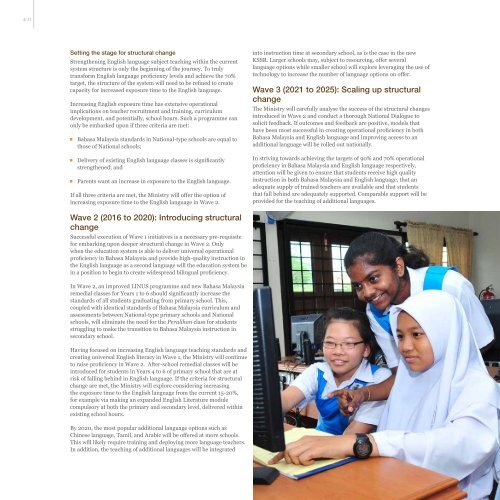Preliminary-Blueprint-Eng
Preliminary-Blueprint-Eng
Preliminary-Blueprint-Eng
You also want an ePaper? Increase the reach of your titles
YUMPU automatically turns print PDFs into web optimized ePapers that Google loves.
4-11<br />
setting the stage for structural change<br />
Strengthening <strong>Eng</strong>lish language subject teaching within the current<br />
system structure is only the beginning of the journey. To truly<br />
transform <strong>Eng</strong>lish language proficiency levels and achieve the 70%<br />
target, the structure of the system will need to be refined to create<br />
capacity for increased exposure time to the <strong>Eng</strong>lish language.<br />
Increasing <strong>Eng</strong>lish exposure time has extensive operational<br />
implications on teacher recruitment and training, curriculum<br />
development, and potentially, school hours. Such a programme can<br />
only be embarked upon if three criteria are met:<br />
▪ Bahasa Malaysia standards in National-type schools are equal to<br />
those of National schools;<br />
▪ Delivery of existing <strong>Eng</strong>lish language classes is significantly<br />
strengthened; and<br />
▪ Parents want an increase in exposure to the <strong>Eng</strong>lish language.<br />
If all three criteria are met, the Ministry will offer the option of<br />
increasing exposure time to the <strong>Eng</strong>lish language in Wave 2.<br />
Wave 2 (2016 to 2020): introducing structural<br />
change<br />
Successful execution of Wave 1 initiatives is a necessary pre-requisite<br />
for embarking upon deeper structural change in Wave 2. Only<br />
when the education system is able to deliver universal operational<br />
proficiency in Bahasa Malaysia and provide high-quality instruction in<br />
the <strong>Eng</strong>lish language as a second language will the education system be<br />
in a position to begin to create widespread bilingual proficiency.<br />
In Wave 2, an improved LINUS programme and new Bahasa Malaysia<br />
remedial classes for Years 1 to 6 should significantly increase the<br />
standards of all students graduating from primary school. This,<br />
coupled with identical standards of Bahasa Malaysia curriculum and<br />
assessments between National-type primary schools and National<br />
schools, will eliminate the need for the Peralihan class for students<br />
struggling to make the transition to Bahasa Malaysia instruction in<br />
secondary school.<br />
Having focused on increasing <strong>Eng</strong>lish language teaching standards and<br />
creating universal <strong>Eng</strong>lish literacy in Wave 1, the Ministry will continue<br />
to raise proficiency in Wave 2. After-school remedial classes will be<br />
introduced for students in Years 4 to 6 of primary school that are at<br />
risk of falling behind in <strong>Eng</strong>lish language. If the criteria for structural<br />
change are met, the Ministry will explore considering increasing<br />
the exposure time to the <strong>Eng</strong>lish language from the current 15-20%,<br />
for example via making an expanded <strong>Eng</strong>lish Literature module<br />
compulsory at both the primary and secondary level, delivered within<br />
existing school hours.<br />
By 2020, the most popular additional language options such as<br />
Chinese language, Tamil, and Arabic will be offered at more schools.<br />
This will likely require training and deploying more language teachers.<br />
In addition, the teaching of additional languages will be integrated<br />
into instruction time at secondary school, as is the case in the new<br />
KSSR. Larger schools may, subject to resourcing, offer several<br />
language options while smaller school will explore leveraging the use of<br />
technology to increase the number of language options on offer.<br />
Wave 3 (2021 to 2025): scaling up structural<br />
change<br />
The Ministry will carefully analyse the success of the structural changes<br />
introduced in Wave 2 and conduct a thorough National Dialogue to<br />
solicit feedback. If outcomes and feedback are positive, models that<br />
have been most successful in creating operational proficiency in both<br />
Bahasa Malaysia and <strong>Eng</strong>lish language and improving access to an<br />
additional language will be rolled out nationally.<br />
In striving towards achieving the targets of 90% and 70% operational<br />
proficiency in Bahasa Malaysia and <strong>Eng</strong>lish language respectively,<br />
attention will be given to ensure that students receive high quality<br />
instruction in both Bahasa Malaysia and <strong>Eng</strong>lish language, that an<br />
adequate supply of trained teachers are available and that students<br />
that fall behind are adequately supported. Comparable support will be<br />
provided for the teaching of additional languages.


